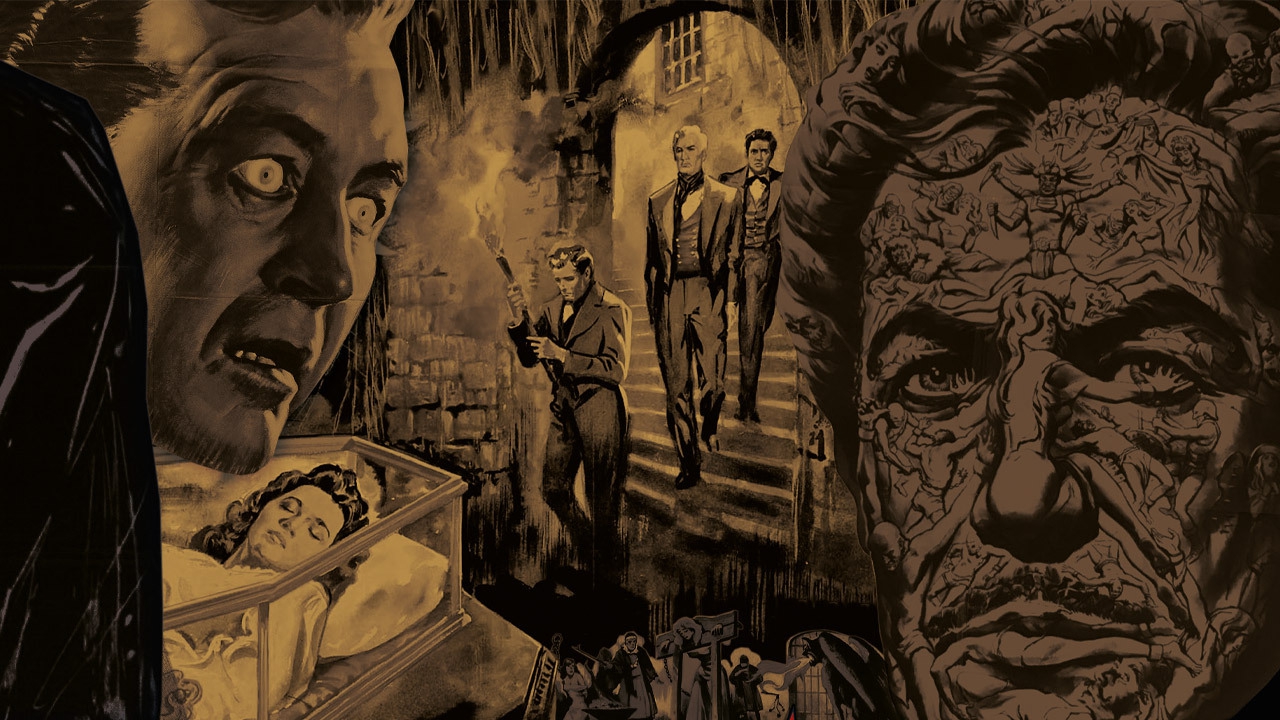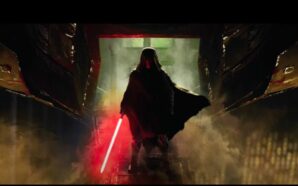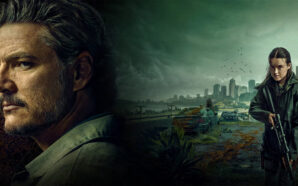Sixty years before Mike Flanagan directed his own eight-part series based on the works of Edgar Allan Poe with Netflix’s The Fall of the House of Usher, another director was bringing the writer’s famed horror works to the screen. Prolific populist Roger Corman began the 1960s with his ‘Poe cycle’, a collection of eight low-budget horror films, all taking their titles, but not necessarily their plots, from Poe’s stories and poems. They are a landmark of gothic horror cinema, at once both flashy and trashy, and all but one starring Vincent Price. To celebrate Halloween I watched them all and had a blast doing so; I present herein my ranking.
8) The Tomb of Ligeia (1964)
The only true out-and-out dud of Corman’s Poe cycle is the oddity that is The Tomb of Ligeia. Whereas in each of his other appearances Vincent Price significantly aids the film, here he hurts it. He isn’t the right fit for Verden Fell, looking far too old to be playing the romantic lead, however much hair dye they utilise, and the morose depression of the character eliminates all of his charm. It’s a subdued performance literally obscured behind dark glasses. The film’s metaphor of a new lover competing against a man’s former love (with the dead wife seemingly not so dead after all) is good but this is the film that hinges the most on romantic chemistry and there just isn’t any. There are a couple of good scenes, with the hypnosis session being the standout, but the film feels like 82 minutes of a cat being thrown at an actress from just off camera, up until the convoluted ending that wants to have its cake and eat it too. It’s worth noting Corman’s location work, with this being the series’ only entry to not be completely shot on a soundstage, but that eliminates the gothic claustrophobic feel. Ultimately, The Tomb of Ligeia just isn’t very fun. Corman’s final Poe film is his worst.
7) Tales of Terror (1962)
Ironically, Tales of Terror is far from terrifying. It’s an anthology film, composed of three stories which allows for Poe’s short stories to remain short, though this sadly hinders the film. The first tale, Morella, is a solid short film in the classic style of Corman’s previous Poe efforts, set in a huge decrepit house, dealing with friction between family members, and has real gothic feel, but the quick runtime means the central relationship has to be rushed from hatred to love very quickly and it falls flat as a result. The second story, The Black Cat, is played for comedy, which would be fine if it wasn’t the same joke over and over again. The screenplay also eliminates some of the unique aspects of the short story, making it feel like a lame version of The Telltale Heart with the ironic twist ending of a Tales of the Unexpected. The third, The Facts in the Case of M. Valdemar, is the highlight, with disturbing visuals, an intriguing premise, and a great villainous performance by Basil Rathbone. It’s too little too late but thankfully leaves the film with some merit and saves it from the worst spot.
6) Premature Burial (1962)
Being buried alive is a recurring motif throughout Corman’s early Poe works and in Premature Burial the concept is given one last gasp, dominating proceedings. This makes the film feel like the most standard and generic entry in the series, simply following the formula, despite also being an oddity. Ray Milland plays the lead, a man terrified of being buried alive as events surrounding him are manipulated until his worst fear becomes a reality. This is the only film of the eight to not feature Vincent Price due to studio deals and contract politicking, and while Milland puts in a good performance it is played perhaps a little too straight and the film misses Price’s knowing charm. The highlight comes from a fantastic black comedy scene where Milland shows off his specially-made tomb, full of escape routes and hidden panels, much to the aghast bafflement of his wife and doctor.
5) The Raven (1963)
The fifth of Corman’s Poe films takes its title from Poe’s poem but that’s about it. Desperate to mix up the formula before it turns stale, the filmmaker made the bold choice to turn Poe’s most famous of works into a straight-up goofy comedy. Shockingly, it just about works. Notably starring three generations of horror legends (Boris Karloff, Vincent Price, and Jack Nicholson) the film instead utilises them in fantasy archetypes and our band of heroes go from one spooky castle to another spookier castle on a quest to battle an evil wizard and find Price’s wife, all while turning Peter Lorre back into a man after he’s cursed to be a talking raven. The fairytale comedy ends with a dialogue-free duel between wizards, featuring some very silly 60s visual effects, and, if you’re in the right mood, it’s great fun. The Raven is complete nonsense in the best way possible.
4) The Haunted Palace (1963)
Despite taking the title of a Poe poem and being considered part of Corman’s Poe cycle, The Haunted Palace is actually the first filmed adaptation of a HP Lovecraft story. This new influence gives the film a unique flavour despite on the surface featuring many of the same elements (literally, with actors, locations, and even stock footage repeating throughout all eight features.) The style of horror is different: instead of Poe’s existential, vaguely supernatural threat, the film features some very real monsters for the characters to face. The town is full of bizarre mutants and an ancient unknowable evil creature lies at the bottom of the castle. It’s a refreshing direction, especially the reembracing of horror after the last couple of films fell back on comedy. The score in fantastic, too. It is perhaps a little overlong, with Price’s flipflopping between hero and villain growing repetitive, and Lon Chaney Jr proving that when he’s not the Wolf Man or Lennie Small, he’s actually not a good actor. The real brilliance of The Haunted Palace however is the sense of scope. It is set over centuries in a town, a castle, and this very cool cavernous chamber location with a massive wooden platform and a hole to Hell. It’s a true testament to Corman’s talent of overcoming the limitations of a modest budget.
3) The Masque of the Red Death (1964)
The issue with The Masque of the Red Death is that it might be too good. It’s classy and a little pretentious, which is certainly not the norm for Corman. Dare I say, a bit arty farty. That makes for a great movie, which Masque definitely is, but while it is Corman’s most accomplished Poe film it’s not my favourite. I like a bit of trashiness, a sprinkle of cheese. Instead, the director is taking everything much more seriously, too much so for my taste, creating his version of Ingmar Bergman’s The Seventh Seal. The film was the first to be filmed in Britain, adding to the new flavour. Price is characteristically great as a real bastard of a villain, a satanist, seemingly untouchable until Death, in the form of a red-cloaked figure, comes knocking. It feels almost Shakespearean, Corman’s Macbeth, and for large swathes of time forgets it’s a horror film. The production design is wonderful, with a resplendent and opulent castle rather than the usual ruinous one, and the use of colour is fantastic and vital to the plot, making the most of cinematographer Nicolas Roeg’s exceptional talent.
2) The Pit and the Pendulum (1961)
What holds The Pit and the Pendulum back from the top spot is that for much of its runtime it feels identical to The Fall of the House of Usher. A young man visits a solitary mansion to find a brother and sister living there, hiding the truth of the horrific happenings occurring within the walls. One could mistake it for a remake the first hour is so similar, albeit with a more boring cast of characters, except for Price, of course. The film may, in fact, feature my favourite of Vincent Price’s performances in a Poe film, getting to portray both tortured victim and eventual madman and murderer. But then the movie enters its final act and the titular pit and pendulum do not disappoint. The final twenty minutes are fantastic. Big and bloody and silly and scary. There are plot reveals I didn’t see coming, as outlandish as the most joyously ludicrous Giallo, the big set piece is pulpy and tense, before the film ends on a deliciously dark final image.
1) The Fall of the House of Usher (1960)
Roger Corman’s first and greatest Edgar Allan Poe adaptation. It’s a fantastic four hander, with each cast member perfect in their very different roles. Price is, of course, the star and on top form but instead of just him elevating the film, the material is elevated by all. The film is both classically gothic and incredibly gaudy, the very best of Corman’s style, as the director clearly revels in the technicolour and cinemascope usually denied his low budget features. It’s the adaptation which best captures the feel and tone of Poe’s story, despite some new additions to the screenplay. The foreboding atmosphere, sense of location, and ambiguous supernatural horror. It’s a haunted house movie and yet, depending on how one wishes to view it, nothing supernatural could be taking place. The Ushers could be cursed or it could all be psychological, leading to a dream sequence which is the creepiest scene in any of the eight films. Thematically and visually rich, The Fall of the House of Usher (or just House of Usher in some markets) is scary when it needs to be but is also balanced with the right amount of archness and camp. It laid the blueprint for what came after but was never bested.











